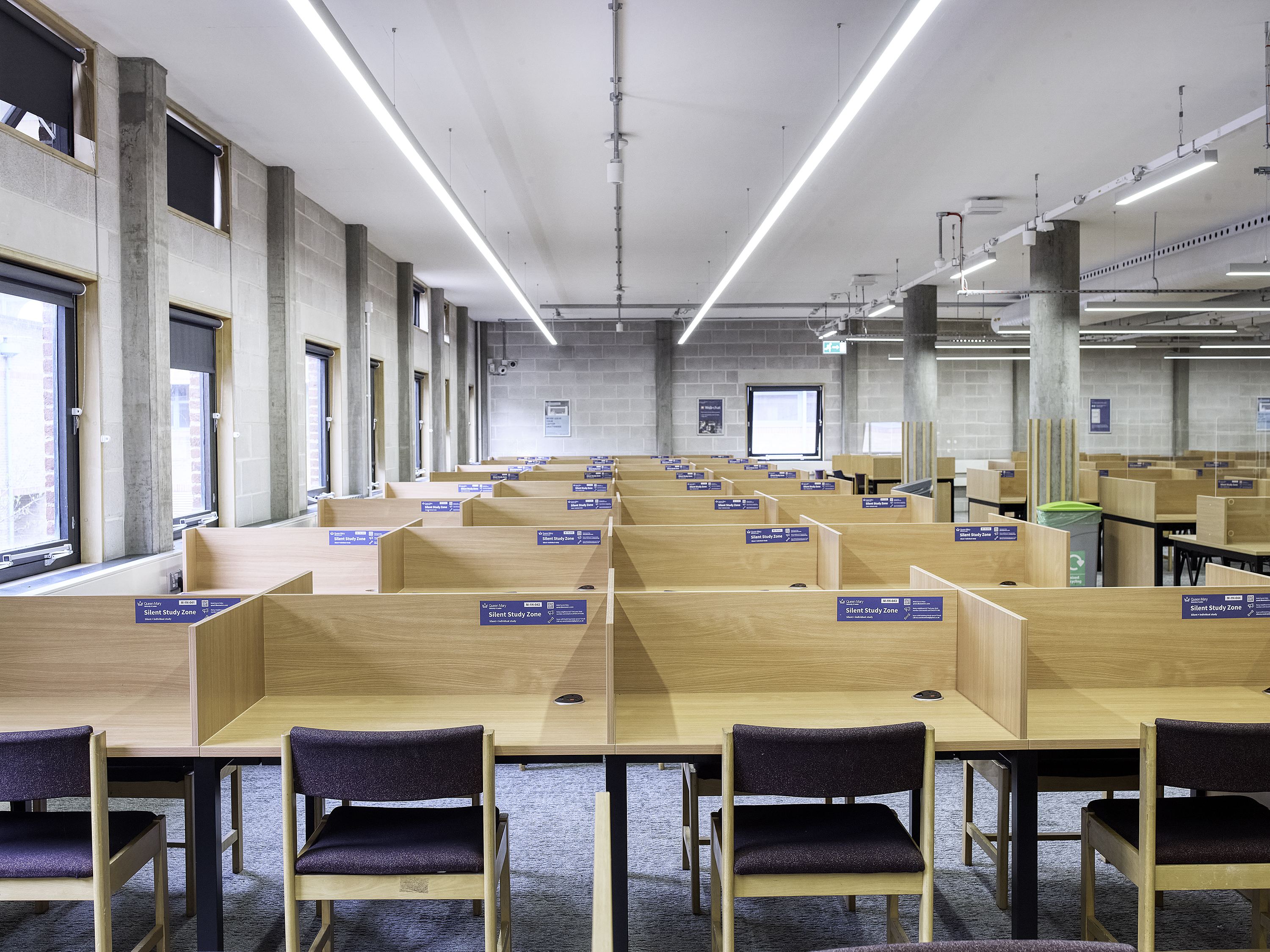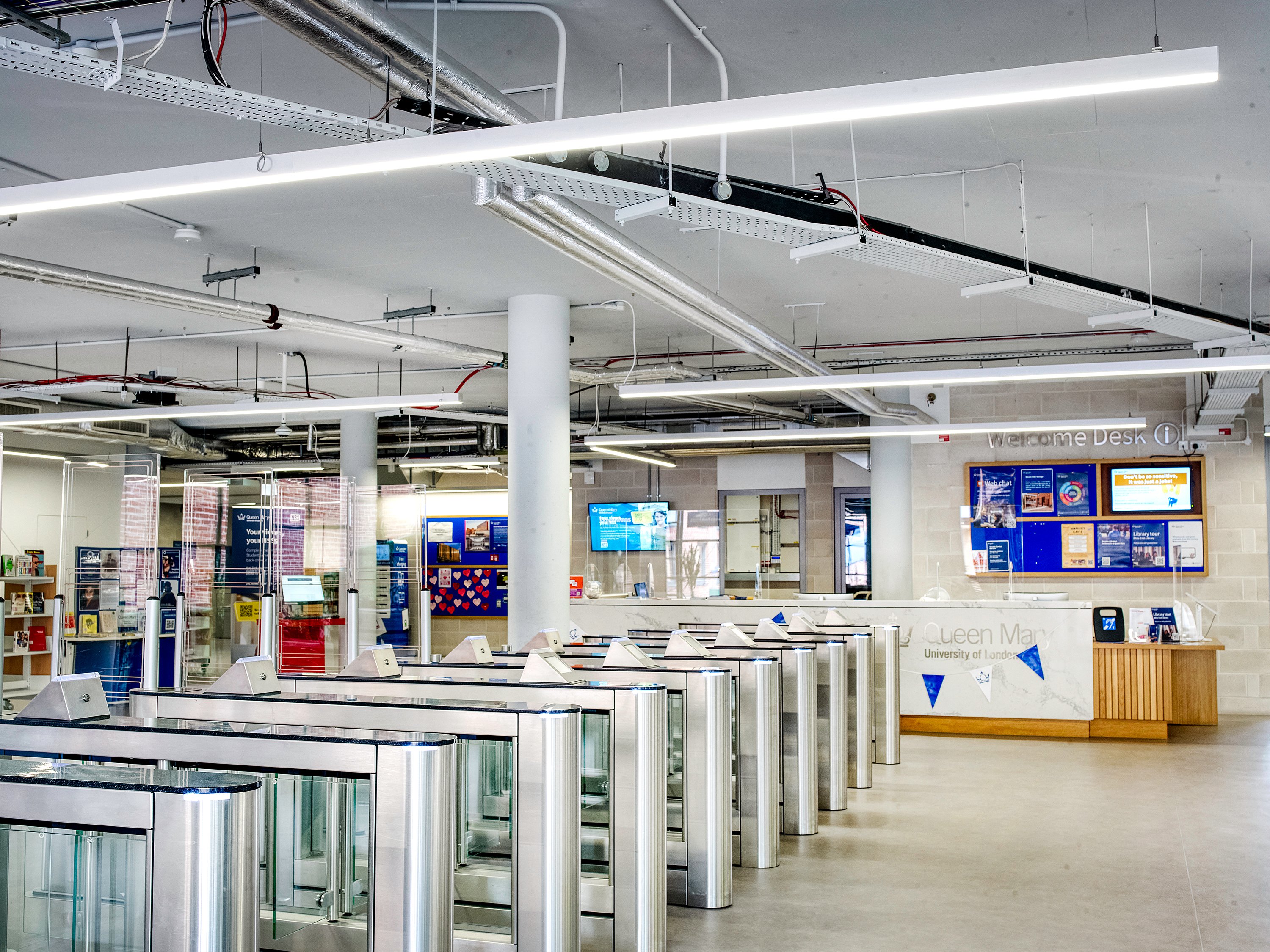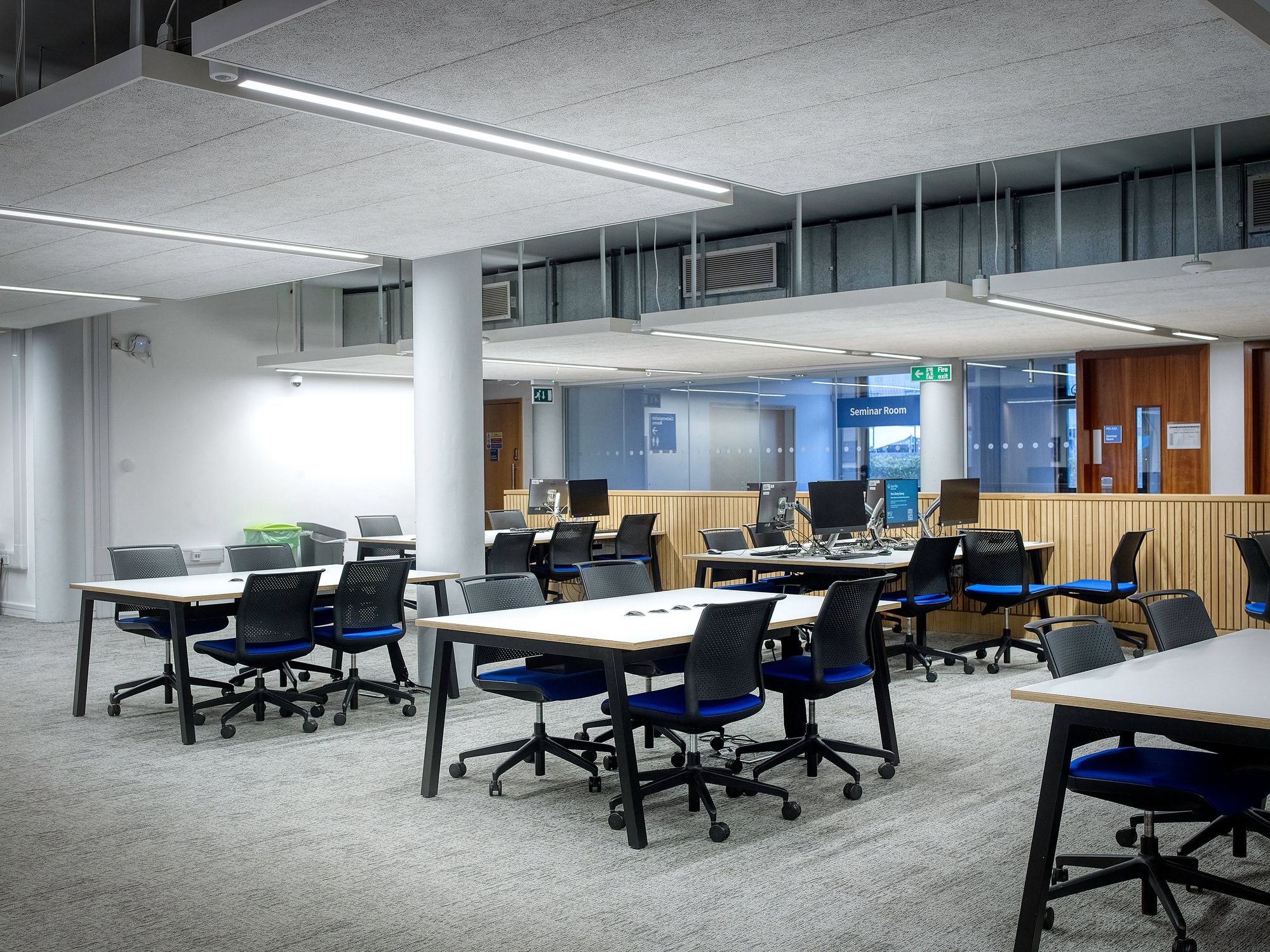
Fagerhult and Queen Mary University of London: A partnership rooted in shared values
Queen Mary University of London (QMUL) is one of the UK's prestigious Russell Group universities, committed to academic excellence and generating a meaningful societal impact.
Find out how Fagerhult became the ideal partner to help tackle lighting challenges at Queen Mary University of London, providing specialised lighting solutions and supporting in creating long-term sustainable practices.
Meeting of minds
Queen Mary University of London (QMUL) is one of the UK's prestigious Russell Group universities, committed to academic excellence and the generation of a meaningful societal impact.
Situated in East London, QMUL offers a stimulating educational environment that balances academic rigor with a rich cultural experience. Its diverse range of programmes, including Medicine, Engineering, Arts and Humanities, caters to an international student body and mirrors its global outlook.
It was a pivotal moment when Richard Frost, Building Services Engineer at QMUL met John Gibson, Fagerhult UK Specification Manager. Fagerhult, known for its commitment to sustainable and human-centric lighting, struck the team at the university as the ideal partner to help tackle its lighting challenges.
Richard’s role was important in identifying the need for a strategic partner who could provide specialised lighting solutions and consult on creating long-term sustainable practices. John Gibson, with his extensive experience and technical expertise, represented the kind of partner who could help QMUL translate its needs into practical strategies.
Bespoke challenge
The quality and sustainability of light fixtures varied significantly across the campus buildings, with the inconsistent lighting quality impacting both the university's environmental footprint and its provision of an optimal study environment. The absence of well-defined design standards complicated the procurement process, making it difficult to find a system that would be both efficient and harmonious with the architectural styles on the campus.
The disparity in lighting systems at the university presented a host of issues, from inconsistent light quality to varying energy efficiency. The latter had ramifications for the university's carbon footprint and its compliance with external regulations, such as the London Plan.
Renowned for its commitment to crafting superior lighting that enhances human well-being and sustainability, Fagerhult was uniquely positioned to provide QMUL with the comprehensive design standards it sought. John Gibson, with a detailed understanding of both the technical aspects of lighting, led the initiative to author superior light planning for a learning environment.
Importantly, these standards were not a one-size-fits-all solution but were tailored to meet QMUL's specific needs. John ensured that they addressed a myriad of concerns - from energy efficiency to the aesthetic and functional integrity of learning spaces.
The result was a set of design standards that resonated with both the University’s immediate and long-term goals. The solution harmonised seamlessly with QMUL's ethos of sustainability and academic excellence whilst enabling feedback that Richard and his team use to make informed decisions on lighting use.
A supportive partnership
The professional alliance between Fagerhult and QMUL has matured into an illustration of how a technical partnership can become a knowledge-sharing platform. Far removed from a typical vendor-client dynamic, there is a culture of open dialogue, where both parties are vested in each other’s growth and success.
John provides Richard with timely updates on emerging technologies, product innovations, and changes in environmental regulations impacting the lighting industry. Richard, armed with this knowledge, can make well-informed decisions for the university, ensuring they stay compliant with evolving standards whilst harnessing technology for energy efficiency and human well-being.
Committed to meeting client needs, Fagerhult have made quick adjustments to their smart lighting systems based on Richard’s feedback. They have changed their technology on occasion to better fit with QMUL's building management, showing a dedication to advanced yet bespoke systems.
Fagerhult reliably meets delivery deadlines thanks to well-coordinated efforts between their UK and Swedish units. This consistency helps QMUL manage its projects more effectively, saving both time and resources that can be used elsewhere.
Delivering consistently
Richard Frost explains more about what makes the relationship distinctive and valuable:
“Our communication lines with Fagerhult have always been transparent and constructive, allowing for a meaningful exchange of ideas and solutions. What sets them apart is their ability to understand the University’s unique challenges and objectives and then come up with tailored solutions.
“Fagerhult isn’t just a supplier, more an extension of our team, contributing to the overarching goal of maintaining an educational and research setting of the highest calibre. It's rare to find a partner that aligns so closely with one’s ethos and that delivers consistently on promises.”
On Fagerhult's side, John Gibson echoes these sentiments:
"Our engagement with Queen Mary University London has allowed us to contribute to an institution with very high standards, and the relationship that has developed over the years is something in which we take great pride.
“It’s a professional connection that adds value to our corporate identity. We’re looking forward to working further with this fantastic learning institution. It is really satisfying to know that we’re helping people to study, learn, and improve their and the world’s future.”
To find out more about lighting solutions for schools and learning environments, visit the Fagerhult Knowledge Hub or get in touch.
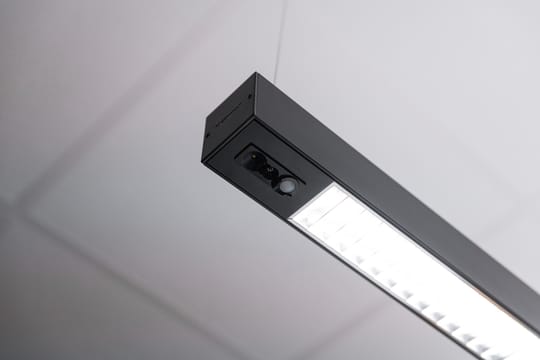
Read more about the Notor family
Fagerhult’s classic interior luminaire Notor is available in several versions for suspended, surface mounted or recessed installation. Notor is an obvious choice in circumstances when there is a desire to create long, unbroken lines of light. Discreet or striking – it is simple to adapt the nature of the lighting with the architecture in mind.
Read moreRelated News

Notor 65 Dynamic - With the light qualities of nature
Sprung out of research, the innovative Notor 65 Dynamic has now seen the light of day – as the first of its kind. With a clear focus on our perceived well-being, it brings the light qualities of nature to our indoor environments. The challenge in our work is to create an indoor light environment that mimics daylight. Is it even possible? With our new luminaire, Notor 65 Dynamic, we have the opportunity to approach this in a completely new way. With a diffuse direct/indirect light, combined with directional light from a spotlight mounted on the side, dynamic and natural-like lighting is created. This to be able to create more motivating environments and increase well-being at the workplace.– This is our fruit from what started out as a joined research project for the past few years, says Cecilia Niva, Product & Application Manager, Fagerhult. With this luminaire we can truly talk about dynamic lighting. We try to capture what is natural in daylight – both a cold diffuse light and a warm directed light. The combination of the two creates dynamic and natural-like lighting, giving us more pronounced shadows, contrasts and colours. It also creates a personal light space, its own zone, with high-quality warm light. In addition, details and textures are easier to see.Notor 65 Dynamic is a part of the familiar luminaire range Notor, and fits perfectly with the rest of the versions included in the in family. It comes in classic black and white, and is a subtle design element in indoor environments such as offices or schools. But despite its appearance, in this case looks is definitely not the main USP – rather than the affect it has on our perceived well-being and comfort. – We see this innovative luminaire as a means to enhance the indoor environments and increase the mental well-being of people working there, Cecilia Niva continues. It is a part of a holistic and sustainable approach to lighting, with an emphasis on balance and health. For us, sustainability and health are about long-term and proactive initiatives. With our solutions, we want to be involved in creating the best conditions for a healthy indoor climate.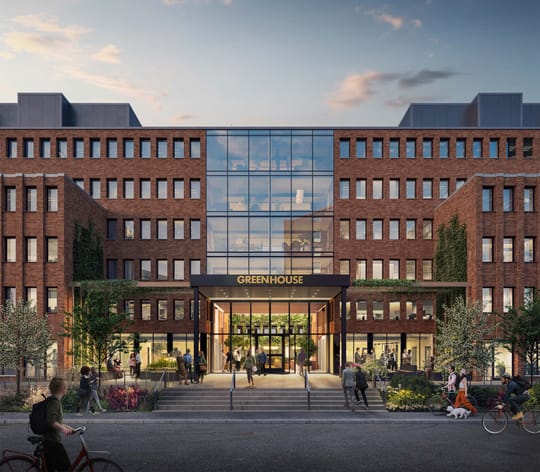
Greenhouse greatly reduced the climate impact by reusing 2 700 luminaires
Sustainable buildings are the only way forward, just ask property developer Humlegården Fastigheter. With three keywords in mind – reusing, recycling and upcycling, Humlegården developed the concept surrounding Greenhouse in Solna Strand. A project focused on refurbishing what is already there and utilising smart lighting control systems to future-proof the building for years to come, and reaching environmental savings of as much as 75 tonnes of carbon dioxide. Creating a space for people and nature Greenhouse is a modern workspace of up to 20,000 square meters with occupancy starting at the end of 2023. It offers a wide range of conference rooms and shared workspaces in an open environment. When navigating the space, you constantly enjoy the change between indoor and outdoor surroundings. The building is defined by its great variation between open landscapes and more intimate meeting spaces, while simultaneously making space for non-work related activities such as yoga, meditation, and sauna. The result is a dynamic work environment generating both great focus and relaxation. "We want to create places where people wish to be and want to return. This requires exciting contexts and a changing environment that supports modern ways of working and is attractive to employees", says Anna Kullendorff, Business development manager at Humlegården. Recycling and reuse in mind Being an beautiful old brick property, the goal of this project was to modernise it in a sustainable way, while still preserving the value of its history. This included, for example, keeping and reusing the interior ceilings, glass partitions, and doors. Since the ceilings were reused, a question arose. Could the luminaires also be restored and updated to meet today’s standards? Fagerhult got involved at an early stage of the project to convert and transform the old luminaires into modern presence- and daylight-controlled LED luminaires. "By refurbishing the luminaires, we were able to achieve significant environmental and economic savings. We could keep the electrical installations, avoid new wiring and making new holes in the ceiling. To future-proof the building, we also installed our plug-and-play lighting control system, Organic Response in every luminaire. Incorporating a control system, ensures a future-proof solution since it creates the possibility to add on services and integrations to a Building Management system, if needed", says Kjell Wallin, Lighting advisor, Fagerhult. Clear goals paved the way for creative solutions For Fagerhult, Greenhouse is the largest refurbish project to date. "Collaborating with a property developer who expresses such clear goals regarding sustainability and refurbishment is exciting. With over 2 700 luminaires, in three different models, being refurbished, we had to think creatively to find practical and sustainable solutions", says Jessica Wahlberg, Fagerhult's Regional manager in Stockholm. However, transporting the luminaires from Solna to Fagerhult and back would entail significant greenhouse gas emissions and undo the environmental benefits of refurbishing the luminaires. So, with sustainability in mind – Fagerhult came up with a different, slightly unconventional, solution. A full-scale production line on-site A full-scale production line was created at Greenhouse where Fagerhult planned and organised all the set-up in close collaboration with the on-site electricians for an efficient workflow. We considered everything from easy transportation of the luminaries inside the building to management of functional tests and recycling by the knowledgeable assemblers. All the old luminaries were disassembled, the luminaire body was reused, and all excess material were sorted into different fractions and recycled. The old light sources were replaced with new LEDs and integrated Organic Response sensors to save energy. Everything was customised to fit into the old luminaire body. "This project required a lot of creative solutions and quick thinking. For example, while transporting the luminaires between different floors we needed to develop special cages since the elevators were too narrow to fit a forklift. On site we found old bread cages that fit into the elevators, these were reconstructed to safely transport the luminaires", says Kjell Wallin, Lighting advisor, Fagerhult. And since we never compromise on safety, Fagerhult also ensured the technical capabilities and safety of the refurbished luminaires. All new luminaire parts were tested at our laboratory according to current standards, which made the assembly at Greenhouse easy and efficient. After a luminaire had been rebuilt, complementary and final tests were also carried out on site. We always focus on high quality in our lighting solutions, regardless of them being old or new. Environmental savings By reusing parts from the luminaires, keeping the old electrical installations, and not needing to make new holes in the ceiling or new cable installations, the refurbishment of the luminaires at Greenhouse has led to significant environmental savings. "By working with Fagerhult to reuse the existing luminaires we have saved 7.1 tons of material and 2,297 megawatt-hours of energy over a 20-year lifecycle. If we also include the environmental savings from fewer transports and less packaging, the environmental benefit becomes even greater", says Clas Boudrie, Project manager at Humlegården. Greenhouse is proof that big steps can be taken within sustainable property development - all through close collaboration, commitment and by embracing an unconventional mindset to make it happen. Read more about Greenhouse here
